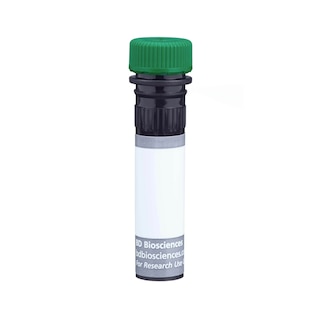Old Browser
This page has been recently translated and is available in French now.
Looks like you're visiting us from {countryName}.
Would you like to stay on the current country site or be switched to your country?




Flow cytometric analysis using BD OptiBuild™ BUV563 Rat Anti-Mouse CD43 antibody (Cat. No. 741238; solid line histogram) on BALB/c mouse bone marrow, with Isotype Control (dotted line histogram). Flow cytometry was performed using a BD LSRFortessa™ X-20 Flow Cytometer System.


BD OptiBuild™ BUV563 Rat Anti-Mouse CD43

Regulatory Status Legend
Any use of products other than the permitted use without the express written authorization of Becton, Dickinson and Company is strictly prohibited.
Preparation And Storage
Recommended Assay Procedures
For optimal and reproducible results, BD Horizon Brilliant Stain Buffer should be used anytime two or more BD Horizon Brilliant dyes (including BD OptiBuild Brilliant reagents) are used in the same experiment. Fluorescent dye interactions may cause staining artifacts which may affect data interpretation. The BD Horizon Brilliant Stain Buffer was designed to minimize these interactions. More information can be found in the Technical Data Sheet of the BD Horizon Brilliant Stain Buffer (Cat. No. 563794).
Product Notices
- This antibody was developed for use in flow cytometry.
- The production process underwent stringent testing and validation to assure that it generates a high-quality conjugate with consistent performance and specific binding activity. However, verification testing has not been performed on all conjugate lots.
- Researchers should determine the optimal concentration of this reagent for their individual applications.
- An isotype control should be used at the same concentration as the antibody of interest.
- Caution: Sodium azide yields highly toxic hydrazoic acid under acidic conditions. Dilute azide compounds in running water before discarding to avoid accumulation of potentially explosive deposits in plumbing.
- For fluorochrome spectra and suitable instrument settings, please refer to our Multicolor Flow Cytometry web page at www.bdbiosciences.com/colors.
- Please refer to www.bdbiosciences.com/us/s/resources for technical protocols.
- BD Horizon Brilliant Stain Buffer is covered by one or more of the following US patents: 8,110,673; 8,158,444; 8,575,303; 8,354,239.
Companion Products






The S7 monoclonal antibody specifically binds to the 115 kDa glycosylated form of CD43 (Ly-48, Leukosialin). CD43 is expressed on IL-7-responsive pro-B cells, plasma cells, peritoneal and splenic CD5+ B cells (B-1 cells), granulocytes, monocytes, macrophages, platelets, natural killer cells, thymocytes, peripheral T cytotoxic/suppressor cells, and most T helper cells, but not resting conventional peripheral B cells. CD43 expression has also been detected on pluripotent hematopoietic stem cells and myeloid, lymphoid, and NK-cell progenitors in the bone marrow. Studies of CD43-deficient mice indicate that CD43 participates in the negative regulation of T-cell activation and adhesion.
The antibody was conjugated to BD Horizon™ BUV563 which is part of the BD Horizon Brilliant™ Ultraviolet family of dyes. This dye is a tandem fluorochrome of BD Horizon BUV395 which has an Ex Max of 348 nm and an acceptor dye. The tandem has an Em Max at 563 nm. BD Horizon BUV563 can be excited by the 355 nm ultraviolet laser. On instruments with a 561 nm Yellow-Green laser, the recommended bandpass filter is 585/15 nm with a 535 nm long pass to minimize laser light leakage. When BD Horizon BUV563 is used with an instrument that does not have a 561 nm laser, a 560/40 nm filter with a 535 nm long pass may be more optimal. Due to the excitation and emission characteristics of the acceptor dye, there may be spillover into the PE and PE-CF594 detectors. However, the spillover can be corrected through compensation as with any other dye combination.

Development References (9)
-
Gulley ML, Ogata LC, Thorson JA, Dailey MO, Kemp JD. Identification of a murine pan-T cell antigen which is also expressed during the terminal phases of B cell differentiation. J Immunol. 1988; 140(11):3751-3757. (Immunogen: Flow cytometry, Fluorescence activated cell sorting, Immunofluorescence, Western blot). View Reference
-
Hardy R, Hayakawa K. Generation of Ly-1 B cells from developmentally distinct precursors. Enrichment by stromal-cell culture or cell sorting. Ann N Y Acad Sci. 1992; 651:99-111. (Biology: Western blot). View Reference
-
Hardy RR, Carmack CE, Shinton SA, Kemp JD, Hayakawa K. Resolution and characterization of pro-B and pre-pro-B cell stages in normal mouse bone marrow. J Exp Med. 1991; 173(5):1213-1225. (Clone-specific: Flow cytometry, Fluorescence activated cell sorting). View Reference
-
Jones AT, Federsppiel B, Ellies LG, et al. Characterization of the activation-associated isoform of CD43 on murine T lymphocytes. J Immunol. 1994; 153(8):3426-3439. (Clone-specific: Western blot). View Reference
-
Moore T, Bennett M, Kumar V. Transplantable NK cell progenitors in murine bone marrow. J Immunol. 1995; 154(4):1653-1663. (Clone-specific: Flow cytometry). View Reference
-
Rolink A, ten Boekel E, Melchers F, Fearon DT, Krop I, Andersson J. A subpopulation of B220+ cells in murine bone marrow does not express CD19 and contains natural killer cell progenitors. J Exp Med. 1996; 183(1):187-194. (Clone-specific: Flow cytometry). View Reference
-
Stockton BM, Cheng G, Manjunath N, Ardman B, von Andrian UH. Negative regulation of T cell homing by CD43. Immunity. 1998; 8(3):373-381. (Clone-specific: Flow cytometry). View Reference
-
Thurman EC, Walker J, Jayaraman S, Manjunath N, Ardman B, Green JM. Regulation of in vitro and in vivo T cell activation by CD43. Int Immunol. 1998; 10(5):691-701. (Biology). View Reference
-
Wells SM, Kantor AB, Stall AM. CD43 (S7) expression identifies peripheral B cell subsets. J Immunol. 1994; 153(12):5503-5515. (Clone-specific: Flow cytometry, Fluorescence activated cell sorting). View Reference
Please refer to Support Documents for Quality Certificates
Global - Refer to manufacturer's instructions for use and related User Manuals and Technical data sheets before using this products as described
Comparisons, where applicable, are made against older BD Technology, manual methods or are general performance claims. Comparisons are not made against non-BD technologies, unless otherwise noted.
For Research Use Only. Not for use in diagnostic or therapeutic procedures.
Report a Site Issue
This form is intended to help us improve our website experience. For other support, please visit our Contact Us page.